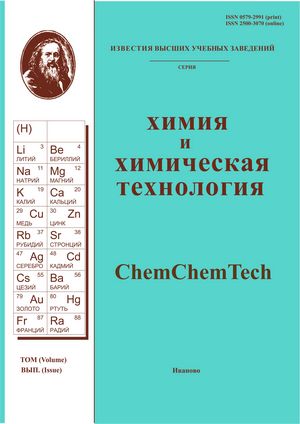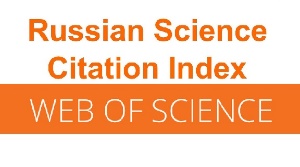СПЕКТРОСКОПИЧЕСКИ И/ИЛИ СТРУКТУРНО ИНТРИГУЮЩИЕ ФТАЛОЦИАНИНЫ И РОДСТВЕННЫЕ СОЕДИНЕНИЯ. ЧАСТЬ 2. МОНОМЕРНЫЕ СИСТЕМЫ
Аннотация
Представлена вторая часть серии обзорных работ по свойствам некоторых синтетически и спектроскопически интересных исследований нашей группы за период 2007-2017 гг. В частности, приведены примеры анализа спектроскопических данных в сочетании с расчетами методом молекулярных орбиталей. Мы использовали в основном спектроскопические методы электронного поглощения и естественного и магнитного кругового дихроизма, периодически применяя флуоресценцию, фосфоресценцию и ЭПР с временным разрешением. Теоретически проанализированы спектры (4n + 2) p систем, а также некоторые 4np антиароматических систем, что помогает читателю интерпретировать спектральные данные. В первой и второй частях этого обзора рассматриваются мономерные системы, а в третьей - тримерные и тетрамерные системы.
. . . . . . . . . . . . . . . . . . . . . . . . . . . . . . . . . . . . . . . . . . . . . . . . . . . . . . .. . . . . . . . . . . . . . . . . . . . . . . . .. . .. . . .. .. .. . . . . . . . . . . . . . . .. . . . . . .. . . .. .. . .. . . . . . . . . .. . . . . . . . . . . . . . . . . . . . . . . . . . . . . . . . . . . . . . . . . . .. .. . . .. . . . . . . . .. .. . . . . . . .. . . . . . . .. . . .. . . . .. . . .. . . . . . .. . . .. .. . . . . . .. . . . .. . .. .. . .
Литература
Zhou Z., Chang Y., Shimizu S., Mack J., Schutt C., Her-ges R., Shen Z., Kobayashi N. Core-Modified Rubyrins Containing Dithienylethene Moieties. Angew. Chem. Int. Ed. 2014. V. 53. P. 6563-6567.
Geuenich D., Hess K., Kçhler F., Herges R. Anisotropy of the Induced Current Density (ACID), a General Method To Quantify and Visualize Electronic Delocalization. Chem. Rev. 2005. V. 105. P. 3758 – 3772.
Lee S., You Y., Ohkubo K., Fukuzumi S., Nam W. Photo-electrocatalysis to Improve Cycloreversion Quantum Yields of Photochromic Dithienylethene Compounds. Angew. Chem. Int. Ed. 2012. V. 51. P. 13154 – 13158.
Wu V., Descalzo A. B., Weik F., Emmerling F., Shen Z., You X.-Z., Rurack K. A Core‐Modified Rubyrin with me-so‐Aryl Substituents and Phenanthrene‐Fused Pyrrole Rings: A Highly Conjugated Near‐Infrared Dye and Hg2+ Probe. Angew. Chem. Int. Ed. 2008. V. 47. P. 193 – 197.
Lindsey J.S., Schreiman I.C., Hsu H.C., Kearney P.C., Marguerettaz A.M. Rothemund and Adler-Longo Reactions Revisited: Synthesis of Tetraphenylporphyrins under Equilib-rium Conditions. J. Org. Chem. 1987. V. 52. P. 827 – 836.
Michl J. Magnetic Circular Dichroism of Cyclic. Pi.-electron Systems. 2. Algebraic Solution of the Perimeter Model for the B Terms of Systems with a (4N +2) π-Electron [n] Annulene Perimeter. J. Am. Chem. Soc. 1978. V. 100. P. 6812-6818.
Muranaka A., Homma S., Maeda H., Furuta H., Koba-yashi N. Detection of unusual ΔHOMO < ΔLUMO relation-ship in tetrapyrrolic cis- and trans-doubly N-confused porphy-rins. Chem. Phys. Lett. 2008. V. 460. P. 495-498.
Howeler U., Downing J.W., Fleischhauer J., Michl J. MCD of Non-Aromatic Cyclic -Electron Systems. Part 1. The Perimeter Model for Antiaromatic 4n-Electron [n]Annulene Biradicals. J. Chem. Soc. Perkin Trans. 1998. V. 2. P. 1101 – 1117.
Fleischhauer J., Howeler M.U., Michl J. Magnetic Circular Dichroism of Non-Aromatic Cyclic -Electron Systems. 2. [1] The Perimeter Model for High-Symmetry ‘Unaromatic’ and ‘Ambiaromatic’ Molecules Derived from 4n-Electron [n]Annulenes. Spectrochim. Acta Part A. 1999. V. 55. P. 585 – 606.
Fleischhauer J., Howeler U., Michl J. MCD of Nonaromatic Cyclic π-Electron Systems. 3. The Perimeter Model for Low-Symmetry “Unaromatic” and “Ambiaromatic” Molecules Derived from 4n-Electron [n]Annulenes. J. Phys. Chem. A. 2000. V. 104. P. 7762 – 7775.
Fleischhauer J., Michl J. MCD of Nonaromatic Cyclic π-Electron Systems. 4. Explicit Relations between Molecular Structure and Spectra. J. Phys. Chem. A. 2000. V. 104. P. 7776 – 7784.
Mack J., Stillman M.J., Kobayashi N. Application of MCD Spectroscopy to Porphyrinoids. Coord. Chem. Review. 2007. V. 251. P. 429-453.
Kobayashi N. Muranaka A., Mack J. Circular Dichroism and Magnetic Circular Dichroism for Organic Chemists (text-book). London: Royal Society of Chemistry. 2012. (com-ments in Angew. Chem. Int. Ed. 2012. V. 51. P. 10446).
Matsushita O., Derkacheva V.M., Muranaka A., Shimizu S., Uchiyama M., Luk‘yanets E.A., Kobayashi N. Rectan-gular-Shaped Expanded Phthalocyanines with Two Central Metal Atoms. J. Am. Chem. Soc. 2012. V. 134. P. 3411-3418.
Engel M.K. Single Crystal Structures of Phthalocyanine Complexes and Related Macrocycles. In “The Porphyrin Handbook”. Ed. By K.M. Kadish, K.M. Smith, R. Guilard. New York: Academic Press. 2003. V. 20. Chap. 122. P. 1-242.
Kobayashi N. Synthesis and Spectroscopic Properties of Phthalocyanine Analogues. In “Handbook of Porphyrins and Related Macrocycles”. Ed. by K.M. Kadish, K.M. Smith, R. Guilard. New York: Academic Press. 2002. V. 15. Chap. 100. P. 161-262.
(a) Moser F.H., Thomas A.L. The Phthalocyanines, Boca Raton, FL: CRC Press. 1983. V. I & II. b) Leznoff C.C. Synthesis of Metal-Free Substituted Phthalocyanines. In “Phthalocyanines: Properties and Applications”. Ed. by C.C. Leznoff, A.B.P. Lever. New York: VCH. 1989. V. 1. Chap. 1. P. 1-54. c) Nemykin V.N., Luk’yanets E.A. The Key Role of Peripheral Substituents in the Chemistry of Phthalo-cyanines. In “Handbook of Porphyrin Science”. Ed. by K.M. Kadish, K.M. Smith, R. Guilard. Singapore: World Scientific. 2010. V. 3. Chap. 11.
Modec B., Sala M., Clerac R. Pyrazine‐Assisted Dimeriza-tion of Molybdenum(V): Synthesis and Structural Characteri-zation of Novel Dinuclear and Tetranuclear Complexes. Eur. J. Inorg. Chem. 2010. V. 2010. N 4. P. 542−553.
Mizutani J., Imoto H., Saito H. Tetrafluoroborate Salt of Tricarbonyl(2‐methoxy‐η5‐cyclohexadienyl)iron(II). Acta Crystallogr. 1997. V. C53. P. 47−50.
Gorsch M., Kienast A., Huckstadt H., Homborg V. High Intensity Trip‐Multiplet Transitions, a Reality! Synthesis, Properties, and Crystal Structure of l‐Bis(triphenylphosphine)iminium trans‐Dibromophthalocyaninato(2–)molybdate(III). Z. Anorg. Allg. Chem. 1997. V. 623. P. 1433−1440.
Frick K., Verma S., Sundermeyer J. Novel Nitrido‐ and Oxo(phthalocyaninato) Complexes of Molybdenum, Tungsten and Rhenium. Eur. J. Inorg. Chem. 2000. V. 5. P. 1025−1030.
Fukuda T., Makarova E.A., Luk’yanets E.A., Kobayashi N. Synthesis and Spectroscopic and Electrochemical Studies of Novel Benzo- or 2,3-Naphtho-Fused Tetraaza-chlorins, -bacteriochlorins, and -isobacteriochlorins. Chem. Eur. J. 2004. V. 10. P. 117-133.
Kobayashi N., Nakajima S., Ogata H., Fukuda T. Synthe-sis, Spectroscopy, and Electrochemistry of Tetra-tert-Butylated Tetraazaporphyrins, Phthalocyanines, Naphthalocy-anines, and Anthracocyanines, together with Molecular Or-bital Calculations. Chem. Eur. J. 2004. V. 10. P. 6294-6312.
(a) Kobayashi N., Fukuda T. First Observation of the Vi-brational Circular Dichroism Spectra of Synthetic Chiral Porphyrazines. Chem. Lett. 2004. V. 33. P. 32−33. (b) Makarova E.A., Fukuda T., Luk’yanets E.A., Kobayashi N. Synthesis, Spectroscopic, and Electrochemical Studies of 1,2-Naphthalene-Ring-Fused Tetraaza-chlorins, -bacteriochlorins, and -isobacteriochlorins: The Separation and Characterization of Structural Isomers. Chem. Eur. J. 2005. V. 11. P. 1235−1250.
(a) Nyokong T. The Oxidation of Oxomolybdenum Phthalo-cyanine. Inorg. Chim. Acta. 1989. V. 160. P. 235−239. (b) Nyokong T. Cyclic Voltammetry and Photooxidation of Mo-lybdenum Phthalocyanine. Polyhedron 1994. V. 13. P. 215−220.
A 14N NMR spectrum was recorded for 2 (not shown). The signal was measured between −1000 and 800 ppm, but only a single peak was observed at −66 ppm. If the structure of 2 were consistent with that of 5B in its core structure, at least two 14N NMR peaks would be anticipated. Although the 1H NMR data can be interpreted for both structures 5A and 5B (Fig. 6), this result also supports the characterization of 2 as 5A.
Gouterman M. In The Porphyrins. Ed. by D. Dolphin. New York: Academic Press. 1978. V. 3. Chap. 1.
Mack J., Stillman M.J. Electronic Structures of Metal Phthalocyanine and Porphyrin Complexes from Analysis of the UV-Visible Absorption and Magnetic Circular Dichroism Spectra and Molecular Orbital Calculations. In “The Porphy-rin Handbook”. Ed. by K.M. Kadish, K.M. Smith, R. Guilard. New York: Academic Press. 2003. V. 16. Chap. 103. P. 43- 116.
Muranaka A., Matsushita O., Yoshida K., Mori S., Su-zuki M., Furuyama T., Uchiyama M., Osuka A., Koba-yashi N. Application of the Perimeter Model to the Assign-ment of the Electronic Absorption Spectra of Gold(III) Hex-aphrins with [4n+2] and [4n] π-Electron Systems. Chem. Eur. J. 2009. P. 15. P. 3744−3751.
Michl J. Electronic Structure of Aromatic π-Electron Systems as Reflected in Their MCD Spectra. Pure. Appl. Chem. 1980. V. 52. P. 1549–1563.
Furuyama T., Sato T., Kobayashi N. A Bottom-up Synthe-sis of Antiaromatic Expanded Phthalocyanines: Pen-tabenzotriaza-smaragdyrins, i.e. Norcorroles of Super-phthalosyanines. J. Am. Chem. Soc. 2015. V. 137. P. 13788-13791.
(a) Mack J., Sosa-Vargas L., Coles S.J., Tizzard G.J., Chambrier I., Cammidge A.N., Cook M.J., Kobayashi N. Synthesis, Characterization, MCD Spectroscopy, and TD-DFT Calculations of Copper Metalated Nonperipherally Sub-stituted Octa-Octyl Derivatives of Tetrabenzotriazaporphyrin, cis and trans Tetrabenzodiazaporphyrin, Tetrabenzomonoaza-porphyrin, and Tetrabenzoporphyrin. Inorg. Chem. 2012. V. 51. P. 12820-12833. (b) Leznoff C.C., McKeown N.B. Preparation of Substituted Tetrabenzotriazaporphyrins and a Tetranaphthotriazaporphyrin: A Route to Mono-meso-Substituted Phthalocyanine Analogs. J. Org. Chem. 1990. V. 55. P. 2186−2190.
Elvidge J.A., Golden J.H. Compounds Containing Directly Linked Pyrrole Rings. Part II. Dialkylimino-β-isoindigos. J. Chem. Soc. 1956. P. 4144−4150.
Mori H., Sung Y.M., Lee B.S., Kim D., Osuka A. Anti-aromatic Hexaphyrins and Octaphyrins Stabilized by the Hy-drogen‐Bonding Interactions of meso‐Imidazolyl Groups. An-gew. Chem., Int. Ed. 2012. V. 51. P. 12459−12463.
Furuyama T., Ogura Y., Yoza K., Kobayashi N. Supera-zaporphyrins: Meso-Pentaazapentaphyrins and One of Their Low-Symmetry Derivatives. Angew. Chem. Int. Ed. 2012. V. 51. P. 11110–11114.
Ito T., Hayashi Y., Shimizu S., Shin J.-Y., Kobayashi N., Shinokubo H. Gram-Scale Synthesis of Nickel(II) Norcor-role: The Smallest Antiaromatic Porphyrinoid. Angew. Chem., Int. Ed. 2012. V. 51. P. 8542− 8545.
a) Okujima T., Jin G., Matsumoto N., Mack J., Mori S., Ohara K., Kuzuhara D., Ando C., Ono N., Yamada H., Uno H., Kobayashi N. Cyclo[8]isoindoles: Ring-Expanded and Annelated Porphyrinoids. Angew. Chem., Int. Ed. 2011. V. 50. P. 5699− 5703. b) Kuzuhara D., Mack J., Yamada H., Okujima T., Ono N., Kobayashi N. Synthesis, Struc-tures, and Optical and Electrochemical Properties of Ben-zoporphycenes. Chem. Eur. J. 2009. V. 15. P. 10060-10069.
Okujima T., Ando C., Mack J., Mori S., Hisaki I., Nakae T., Yamada H., Ohara K., Kobayashi N., Uno H. Acenaphthylene-Fused Cyclo[8 ]pyrroles with Intense Near-IR-Region Absorption Bands. Chem. Eur. J. 2013. V. 19. P. 13970-13978.
Okujima T., Ando C., Agrawal S., Matsumoto H., Mori S., Ohara K., Hisaki I., Nakae T., Takase M., Uno H., Kobayashi N. Template Synthesis of Decaphyrin without Meso-Bridges: Cyclo[10]pyrrole. J. Am. Chem. Soc. 2016. V. 138. P. 7540-7543.
a) Seidel D., Lynch V., Sessler J.L. Cyclo[8]pyrrole: A Simple‐to‐Make Expanded Porphyrin with No Meso Bridges. Angew. Chem. Int. Ed. 2002. V. 41. P. 1422–1425. b) Gorski A., Köhler T., Seidel D., Lee J. T., Orzanowska G., Sessler J. L., Waluk. Electronic Structure, Spectra, and Magnetic Circular Dichroism of Cyclohexa‐, Cyclohepta‐, and Cyclooc-tapyrrole. Chem. Eur. J. 2005. V. 11. P. 4179 – 4184.
Ito S., Uno H., Murashima T., Ono N. Synthesis, Proper-ties and Crystal Structures of Rigid Porphyrins Fused with Bicyclo[2.2.2]octene Units. Chem. Commun. 1999. P. 2275 – 2276.
Kobayashi N., Nakai K. Applications of Magnetic Circular Dichroism Spectroscopy to Porphyrins and Phthalocyanines. Chem. Commun. (Feature Article). 2007. P. 4077-4092.
Muranaka A., Matsushita O., Yoshida K., Mori S., Su-zuki M., Furuyama T., Uchiyama M., Osuka A., Koba-yashi N. Application of the Perimeter Model to the Assign-ment of the Electronic Absorption Spectra of Gold(III) Hex-aphyrins with [4n+2] and [4n] -Electron Systems. Chem. Eur. J. 2008. V. 15. P. 3744-3751.
Yoshida T., Zhou W., Furuyama T., Leznoff D.B., Koba-yashi N. An Extremely Air-Stable 19π Porphyrinoid. J. Am. Chem. Soc. 2015. V. 137. P. 9258-9261.
Mack J., Stillman M.J. Photochemical Formation of the Anion Radical of Zinc Phthalocyanine and Analysis of the Absorption and Magnetic Circular Dichroism Spectral Data. Assignment of the Optical Spectrum of [ZnPc(-3)]-. J. Am. Chem. Soc. 1994. V. 116. P. 1292−1304.



















